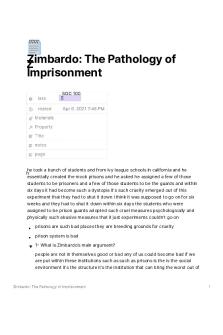Torts sem 1 - summary False Imprisonment PDF

| Title | Torts sem 1 - summary False Imprisonment |
|---|---|
| Course | Torts - Part A |
| Institution | University of Newcastle (Australia) |
| Pages | 2 |
| File Size | 116.3 KB |
| File Type | |
| Total Downloads | 31 |
| Total Views | 140 |
Summary
Download Torts sem 1 - summary False Imprisonment PDF
Description
False Imprisonment: As per Kyrou J in Slaveski v Victoria [2010] VSC 441: [246] ‘... false imprisonment is the wrong of intentionally and without lawful justification subjecting another to a total restrained of movement by either actively causing his confinement or preventing him from exercising his privilege of leaving the place in which he is.’ Elements Total restraint of freedom
Directness (Did D’s conduct directly cause P’s confinement)
Intentional (or negligent) (Did D intend or negligently cause P’s confinement)
*Absence of lawful Justification (defence)
Cases - Restraint must be total not partial: see Bird v Jones (1845) 7 QB 742. - Total restraint implies all reasonable avenues of escape must be cut off - ‘prison’ does not have to be physical walls; it may be a situation where there is no ‘reasonable way out’: see Zanker v Vartzokas (trapped in speeding car = falsely imprisoned) - Someone may be imprisoned by force of authority (WORDS ALONE) and a fear that they will be punished if they try to get away: see Symes v Mahon [1922] SASR 447 & Myer Store Ltd v Soo [1991] 2 VR. - A range of threats may lead to someone being imprisoned: - Person does not have to be aware of the imprisonment: see Murry v Ministry of Defence [1988] 1 WLR 692, Trevorrow v SA (No 5) [2007] SASC 285. (however, this was overturned by the Court of Appeal because of parental control), Lassanah v State of New South Wales (No 3) [2010] NSWDC 241(court ruled that an action in false imprisonment can be brought on behalf of a disabled person) Harm must be direct. - To dig a hole that someone fell into later may not amount to false imprisonment. - Constraint by a police officer where private defendant was directly involved: See Dickinson v Waters Ltd (1931) 31SR (NSW) 593. Myer Stores Ltd v Soo [1991] 2 VR 589 - Coles Myer Limited v Thompson [2009] NSWCA 299 employees of Coles detained two men while waiting for police. - in Lassanah v State of New South Wales (No. 3) [2010] NSWDC 241 a jewellery store was held liable for false imprisonment where staff had pressed a “hold-up” button leading to police wrongfully detaining a mentally disabled man and his carer: - Negligently locking someone in a storeroom? Possible but there is no decided case. - However, there can be false imprisonment even though the person doing the imprisoning thought they were acting under lawful authority: see Cowell v Corrective Services Commission of NSW (1988) 13 NSWLR 714 (Prisoner served a longer time than he should have) - To escape liability the defendant needs to establish legal justification: see State of New South Wales v Smith [2017] NSWCA 194.
Defence – lawful authority -
-
Defendant must prove this In cases where lawful authority is claimed by the police, the power given by common law and statute must be used for the purposes for which is given, not for other purposes: see Prior v Mole [2017] HCA 10 Arrest cannot be used to investigate a crime it can only be done to bring before a judicial officer to be formally charged: Zaravinos v State of NSW [2004] NSWCA 320.
-
The person being arrested must be informed of the reason for their arrest: NSW v Riley [2003] NSWCA 208...
Similar Free PDFs

False imprisonment cases
- 3 Pages

245245808 False Imprisonment Project
- 12 Pages

False imprisonment notes
- 4 Pages

Torts sem1 - summary Detinue
- 1 Pages

Torts Negligence Summary
- 16 Pages

LAWS212 - Torts Notes - Summary
- 40 Pages

Hagseed imprisonment
- 1 Pages

Torts Course Summary Combined
- 123 Pages

COMP10001 Mid Sem Summary
- 6 Pages
Popular Institutions
- Tinajero National High School - Annex
- Politeknik Caltex Riau
- Yokohama City University
- SGT University
- University of Al-Qadisiyah
- Divine Word College of Vigan
- Techniek College Rotterdam
- Universidade de Santiago
- Universiti Teknologi MARA Cawangan Johor Kampus Pasir Gudang
- Poltekkes Kemenkes Yogyakarta
- Baguio City National High School
- Colegio san marcos
- preparatoria uno
- Centro de Bachillerato Tecnológico Industrial y de Servicios No. 107
- Dalian Maritime University
- Quang Trung Secondary School
- Colegio Tecnológico en Informática
- Corporación Regional de Educación Superior
- Grupo CEDVA
- Dar Al Uloom University
- Centro de Estudios Preuniversitarios de la Universidad Nacional de Ingeniería
- 上智大学
- Aakash International School, Nuna Majara
- San Felipe Neri Catholic School
- Kang Chiao International School - New Taipei City
- Misamis Occidental National High School
- Institución Educativa Escuela Normal Juan Ladrilleros
- Kolehiyo ng Pantukan
- Batanes State College
- Instituto Continental
- Sekolah Menengah Kejuruan Kesehatan Kaltara (Tarakan)
- Colegio de La Inmaculada Concepcion - Cebu






